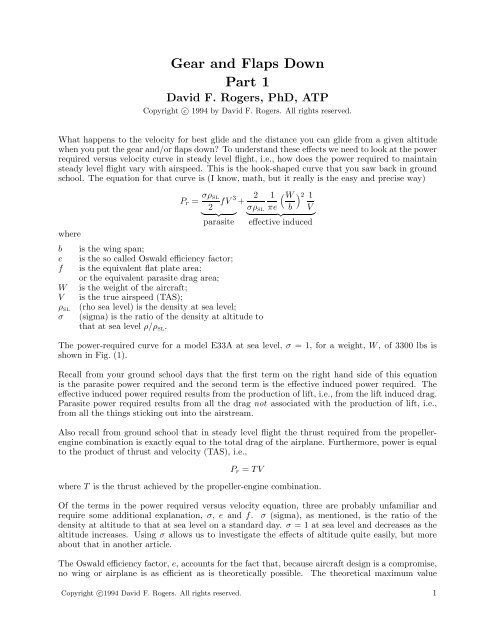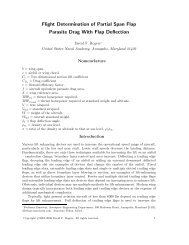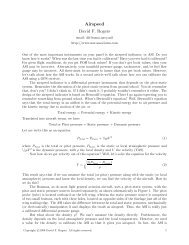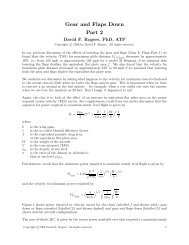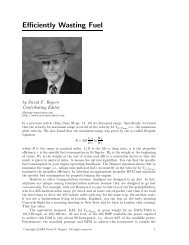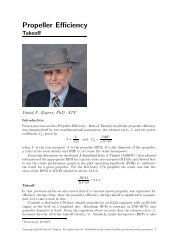Gear and Flaps Down Part 1 - NAR Associates
Gear and Flaps Down Part 1 - NAR Associates
Gear and Flaps Down Part 1 - NAR Associates
Create successful ePaper yourself
Turn your PDF publications into a flip-book with our unique Google optimized e-Paper software.
200E33AW = 3300 lbsSea level160120Power required (hp)804000 20 40 60 80 100 120 140 160 180 200Velocity (mph)Figure 1.Power required.for the Oswald efficiency factor is one. The smaller the value of e the less efficient the aircraft.The Oswald efficiency factor affects the effective induced power required, i.e., the power requiredassociated with the production of lift. Typical values for light aircraft are from 0.5 to 0.8. Basedon flight test results, the Bonanza, with gear <strong>and</strong> flaps up, i.e., clean, has an Oswald efficiencyfactor of approximately 0.56 to 0.65. Extending the gear <strong>and</strong>/or flaps has some effect, but not avery large one, on the value of e.The equivalent flat plate area, f, is the size of a flat plate held normal or perpendicular to the airstream which has the same parasite drag as the airplane. The Bonanza has an equivalent flat platearea of approximately 3.5 square feet. To put this number in perspective, this is less than the areaof four 12 inch square floor tiles, or a bit more than that of six 9 inch square tiles. As we all know,the Bonanza is a slippery aircraft, <strong>and</strong> the small value of f is indicative of that fact.In looking at the power required versus velocity curve in Fig. (1), we see that the curve has aCopyright c○1994 David F. Rogers. All rights reserved. 2
minimum or smallest value at some velocity. This minimum value is given by the equation †P rmin =2.48 f 1/4√σρSL( 1πe) 3/4 ( Wb) 3/2<strong>and</strong> the velocity (TAS) at which it occurs is given by the equation√ √( 4 ) 1/4 1 WV Prmin =3πfe σρ SL bThe P rmin <strong>and</strong> V Prmin are marked in Fig. (1) with a horizontal line <strong>and</strong> a vertical line, respectively.We need one additional concept before discussing the effect of gear <strong>and</strong> flap extension on the bestglide velocity. Notice the alternating short <strong>and</strong> long dashed line through the origin (0, 0) justtangent to (just touching) the power required curve in Fig. (1). The point at which this line justtouches the power required curve gives the velocity (TAS) for maximum glide distance. Technicallythis velocity is known as the velocity for maximum lift to drag ratio, V L/Dmax <strong>and</strong> is given by theequation( 2 W 1 ) 1/2V L/Dmax = √σρ SL b πfeNow, what happens when we extend the gear (or flaps)? The equivalent flat plate area, f, increases.Look at the equation for P rmin . If f increases then the P rmin increases <strong>and</strong> the curve moves up,as shown by the curve drawn with long dashes in Fig. (2). The drag increases, <strong>and</strong> consequentlythe power required to maintain level flight at the same velocity also increases. We know this fromexperience, but the equation shows why this happens.Looking at the equation for V Prmin ,weseethatf is in the denominator (on the bottom). If fincreases, then V Prmin decreases. Consequently, the curve moves to the left toward a lower velocity(TAS), as shown by the curve drawn with short dashes in Fig. (2). The combined effect is to movethe curve up <strong>and</strong> to the left. This curve is drawn with a solid line.Now let us look at what happens to the velocity for best glide, V L/Dmax . The tangent through theorigin to this new curve with increased equivalent flat plate area, drawn with alternating short <strong>and</strong>long dashes, shows that the velocity for best glide significantly decreases compared to the originalcurve. In addition, notice that f occurs in the denominator of the equation for V L/Dmax ,whichalsoshows that the best glide velocity decreases when f increases. Thus, if you have to glide with thegear <strong>and</strong>/or the flaps down you need to slow down to optimize the glide distance.To see what happens to the glide distance when the gear <strong>and</strong>/or the flaps are extended, look at theangle, γ, between the line through the origin tangent to the power required curve <strong>and</strong> the horizontalaxis. In Fig. (2) this line is shown with short <strong>and</strong> long dashes for both the original power requiredcurve <strong>and</strong> for the gear <strong>and</strong> flaps extended power-required curve. The smaller the angle the fartheryou can glide. In fact, this angle represents the ratio of drag to lift, ‡ D/L, which is the reciprocalof the lift to drag ratio, L/D. TheL/D ratio represents the number of feet you can glide forward† Do not be concerned about the exponents. You can do these with a simple $10 calculator which has a square rootfunction √ . The () 1/4 means take the √ twice <strong>and</strong> the () 3/4 means multiply the quantity by itself twice, <strong>and</strong>take the √√ √twice e.g., 1 × 1 × 1 <strong>and</strong> πe πe πe ()3/2 means multiply the quantity by itself twice <strong>and</strong> take the √once.‡ Actually. D/L =tan −1 γ.Copyright c○1994 David F. Rogers. All rights reserved. 3
3ffV L/ Dmax(dirty)Power requiredV L/ Dmax(clean)P rminγ dirtyγ cleanVelocity (TAS)Figure 2.Effect of parasite drag on power required.for every foot of altitude, i.e.,Glide distance d = L h height above groundDLowering the gear can more than double the equivalent flat plate area. Extending 30 ◦ of flaps has asimilar effect. Thus, lowering the gear <strong>and</strong> extending 30 ◦ of flaps can more than triple the value off. These are the effects shown in Fig. (2). The values are representative of the Bonanza. Looking atFig. (2) shows that there is a large decrease in both the velocity (TAS) for maximum glide distance<strong>and</strong> the actual distance you can glide from a given altitude when you lower the gear <strong>and</strong>/or theflaps. The decrease in velocity for maximum glide distance with an increase in equivalent flat platearea can be determined from the equation for V L/Dmax .TheratioofV L/Dmax dirty, i.e., with gear<strong>and</strong>/or flaps down, to that in the clean configuration isV L/Dmax ( (dirty) fclean) 1/4=V L/Dmax f (clean) dirtyAs mentioned, for a Bonanza lowering the gear approximately doubles the equivalent flat plateCopyright c○1994 David F. Rogers. All rights reserved. 4
area, f. Thus, with the gear downV L/Dmax ( (dirty) 1 ) 1/4= =0.84V L/Dmax 2(clean)which shows that V L/Dmax decreases by approximately 16% from the clean best glide speed.(dirty)For a model E33A at a weight of 3300 lbs, the best glide speed decreases to 103 mph from the cleanbest glide speed of 122 mph.For a Bonanza, lowering the gear <strong>and</strong> extending the flaps to 30 ◦ approximately triples the equivalentflat plate area, f. For this configurationV L/Dmax ( (dirty) 1 ) 1/4= =0.76V L/Dmax (clean)3which shows that V L/Dmax decreases by approximately 24% from the clean best glide speed.(dirty)For a model E33A at a weight of 3300 lbs, the best glide speed with gear <strong>and</strong> flaps down decreasesto 93 mph from the clean best glide speed of 122 mph. These are significant effects.One additional very important comment is in order. These results are only approximate, because theactual increases in the equivalent flat plate area are not currently known. Some preliminary flighttests indicate that they are about right. More extensive flight tests are in progress. If successful,the results will be reported in future articles. However, even in that case, the results will only applyto a specific aircraft.In <strong>Gear</strong> & <strong>Flaps</strong> <strong>Part</strong> 2, we talk about what happens to the velocity for maximum rate of climb<strong>and</strong> the actual rate of climb when you have the gear <strong>and</strong>/or flaps extended. If you look at thepower required curve <strong>and</strong> think about it for a bit, you can anticipate the discussion.Copyright c○1994 David F. Rogers. All rights reserved. 5


